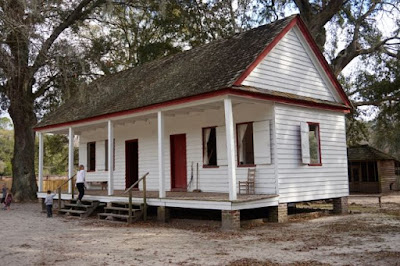 |
| Photo courtesy of Middleton Place |
Middleton Place consists of 65 acres of the oldest landscaped gardens in the United States. They have one of the largest and centuries old collection of camellia's in the U.S.
The weather was so warm in February when we toured that both the camellias and azaleas were blooming.
 |
| Camellia in foreground, Azalea in background |
The camellias come in a stunning array of colors from white
to pink
to red
John Williams first established the plantation in 1730 with it's stunning views of the Ashley River. He situated the house to catch summer breezes. At his death, the plantation passed to his daughter Mary as part of her dowry. She married Henry Middleton who eventually became one of the wealthiest South Carolina planters, owning 50,000 acres and 800 slaves.
 |
| The remaining south flanker (photo courtesy of Wikipedia) |
The main house was completed in 1741 with two flankers built in 1755. The main house and north flanker were destroyed by Union troops in 1865.
The Middleton family played a large part in U.S history. Mary and Henry's son, Arthur, signed the Declaration of Independence. Later Arthur was imprisoned for several years by the British during the Revolution. He was eventually freed. The British signed the terms of surrender to leave the southern colonies at the Middleton Plantation in 1783.
Arthur's son, Henry, experimented with both plants an animals, importing water buffalo from Constantinople to use in the mucky rice paddies. Henry entertained the French botanist Andre Michaux. He presented Henry with a house gift of Camellia's, the first in America.
 |
| Oldest Camellia |
Williams Middleton inherited the plantation from Henry. Williams was one of the signers of the Ordinance of Secession, igniting the Civil War.
 |
| South Carolina's Century Live Oak |
Middleton Plantation fell on hard times after the Civil War, the houses and gardens in ruins. A new roof on the south flanker kept the family in place until 1900 when the house passed to Williams daughter, Elizabeth.
When Elizabeth died in 1915, she passed the plantation on to her cousin, John Julius Pringle Smith, a great-great-grandson of the original Henry.
Smith and his wife, Heningham, labored for years to restore the house and gardens, using the house as their winter retreat. In 1920, they opened the gardens for public tours.
In the 1970's, the house restored, the plantation was transferred to the Middleton Place Foundation, and is now run as a non-profit.
In addition to the house and extensive gardens, visitors can tour the stable yards home to heritage breeds which would have been part of the plantation.
Visitors can also see the many contributions of the slaves to the plantation, where they lived and how they worked.
Hope you enjoyed this tour of the Middleton Plantation. If you missed the Brookgreen tour last week, you can find it here.












No comments :
Post a Comment